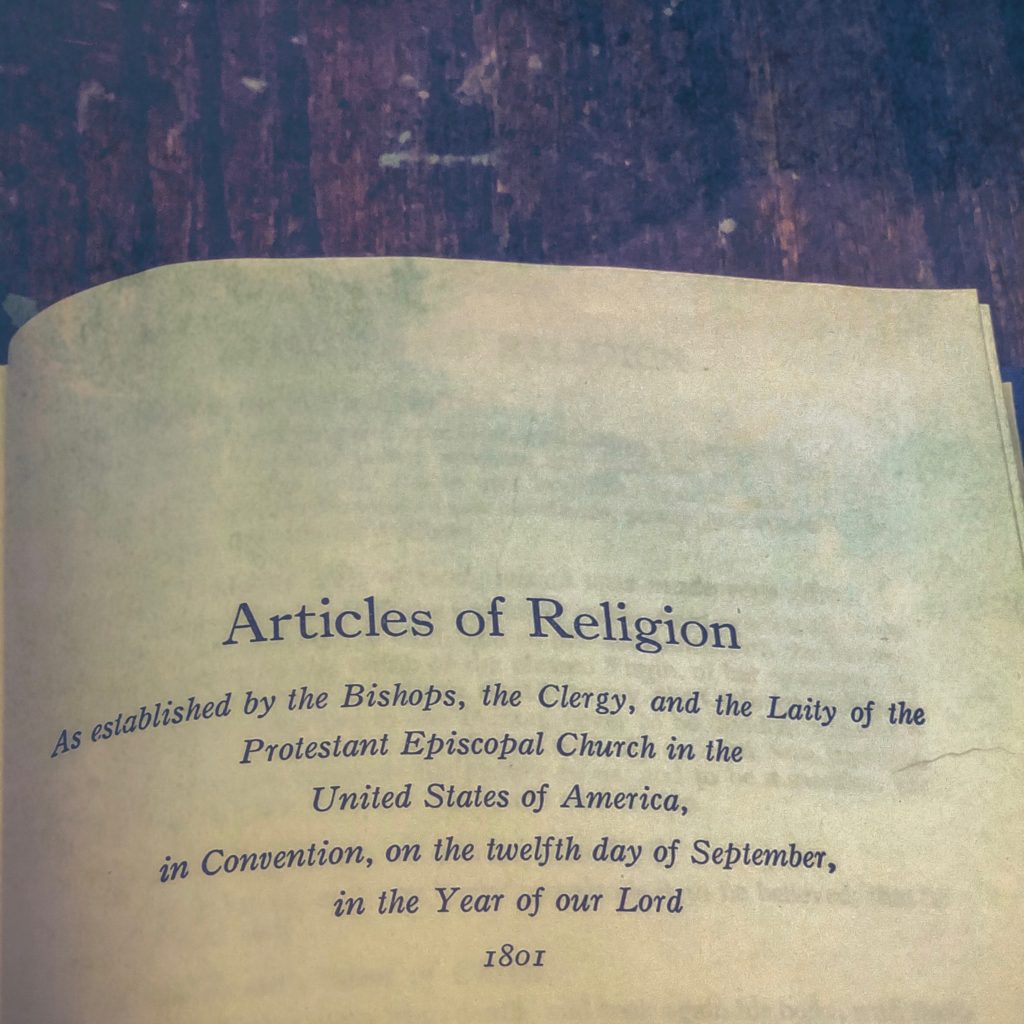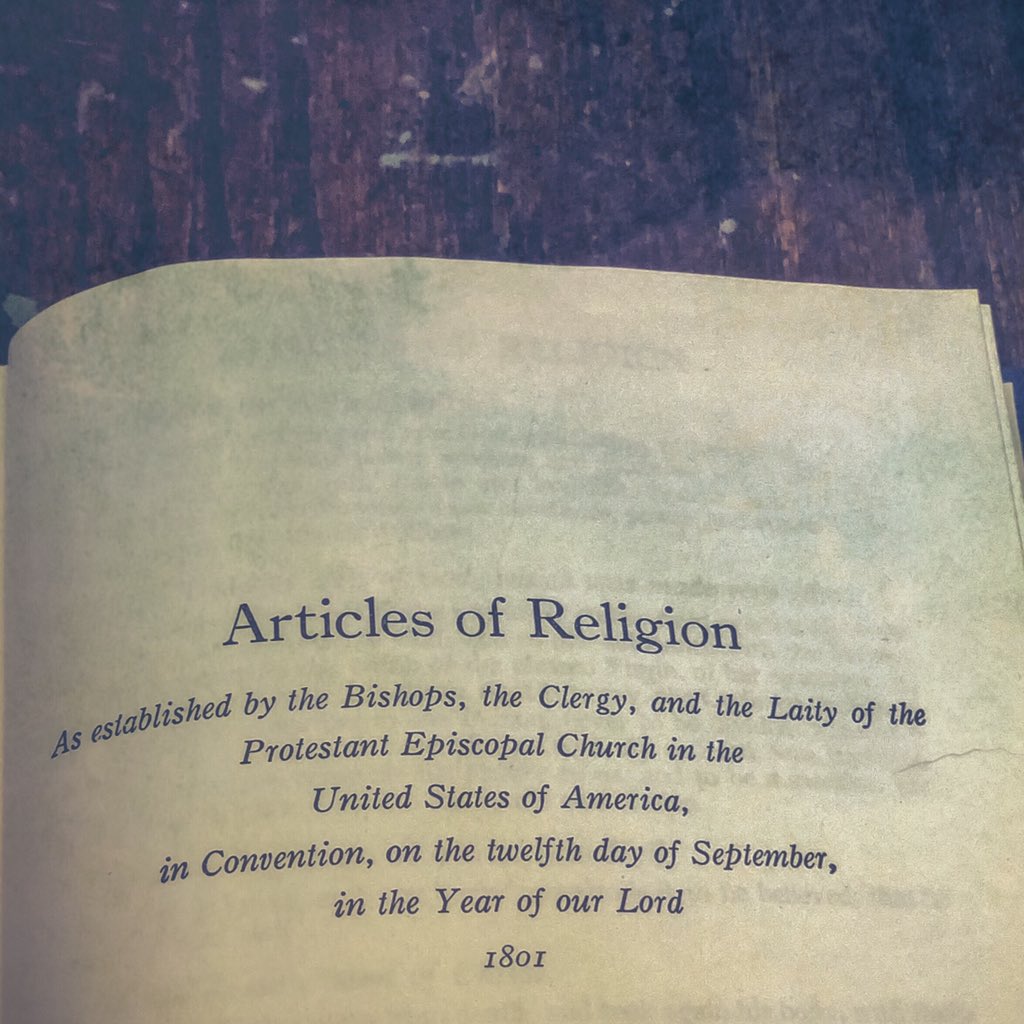
We are accounted righteous before God, only for the merit of our Lord and Savior Jesus Christ by Faith, and not for our own works or deservings: Wherefore, that we are justified by Faith only is a most wholesome Doctrine, and very full of comfort, as more largely is expressed in the Homily of Justification.
by Ben Crosby
When is the last time that you heard a sermon or Christian education session dealing with the question of justification? The Lutherans are fond of calling this doctrine the one upon which the church stands or falls, but for us Episcopalians the term ‘justification’ only appears once in the parts of the 1979 Book of Common Prayer which determine doctrine, namely, in the collect for Friday in Easter Week. Recently, however, the works of the Rev. Fleming Rutledge and Mockingbird Ministries have brought new attention to this theological locus (although Rutledge tends to prefer the term “rectification”). And for good reason! For the questions the doctrine of justification seeks to answer are central ones for Christian life and faith: How can we sinful humans stand before a perfectly good, perfectly just God? Where, exactly, do we look for our salvation from sin, as a power outside us that oppresses us and within us which twists even our most laudable projects away from love of God and service to neighbor? Article XI provides an answer: our salvation is found in the life, death, and resurrection of Jesus Christ, not in anything we can accomplish or earn. God counts us as righteous because of Christ’s righteousness, which we participate in through faith. This answer, I hope to show, remains a vital one for the proclamation of the Gospel today.
First, a little history: the 1571 Article XI of the Thirty-Nine Articles is not the first time that an Anglican formulary dealt with the question of justification. The Ten Articles of 1536, the first doctrinal formulary put forth in the reign of Henry VIII, argue that justification is “remission of our sins, and our acceptation or reconciliation into the grace and favour of God” due to God’s mercy toward us because of the “merits” of Christ’s death for us. Thus far this is quite similar to the doctrine’s eventual form in Article XI of the Thirty-Nine Articles, but the Ten Articles stop short of unqualifiedly endorsing justification by faith alone: it is faith formed by charity that justifies. The 1543 A Necessary Doctrine and Erudition for Any Christian Man, the conservative “King’s Book” produced towards the end of Henry’s life, in fact explicitly rejects justification by faith alone: “no faith is sufficient to justification or salvation, but such a faith as worketh by charity.” It is not that a true faith will of necessity generate good works, as Article XII of the Thirty-Nine Articles will argue; rather, it is an argument that the the virtue of charity is in fact a necessary addition to faith for salvation. Unsurprisingly, this position will come to be reversed in the more Reformed Edwardine Forty-Two Articles of 1553. A version of what will become Article XI of the Thirty-Nine Articles appears as Article XI of the Forty-Two Articles. Here an Anglican formulary states for the first time that justification is by “onely faith,” not faith in addition to something else. The article was then expanded by Archbishop of Canterbury Matthew Parker for the 1571 Thirty-Nine Articles via an adaptation of the language on justification from the Württemberg Confession, a document drawn up by the Lutherans of Württemberg to set forth the Lutheran position at the Council of Trent. It is worth noting that in both its 1553 and its 1571 versions, this article is unique in that it references a specific Homily, the “Homily of Justification,” a title which, amusingly, is not a title of a homily from either the First or Second Book of Homilies. Commentators unanimously agree that it must refer to the Homily of Salvation from the First Book of Homilies, although some suggest that it may also intend to include the homilies immediately before and after as well.
To talk about justification in Article XI is necessarily to wade into some fairly technical theological terminology – imputation and infusion, formed and unformed faith, being declared righteous vs. being made righteous, and more – so it helps to keep in mind the core existential theological question: how can I be right with God? It may well be that many of us have lost the conception of our own sinfulness which gives this question its weightiness. Indeed, perhaps the closest we get to justification language in much contemporary popular theology is the truism that ‘God accepts us just as we are’ – a statement which can certainly be given an orthodox meaning, but also threatens to construe God as a sort of indulgent grandparent and minimizes the role of sin, personal and structural, in our lives and the lives of those we love. For me, it was my heavy involvement in left-wing political organizing in college which forced me to take sin more seriously. Lives shattered for no good reason by poverty or cruelty, my own inextricable participation in the structures of oppression I deplored, and my utter inability to set things aright for myself or those around me all made it crystal clear to me that moral evil in the world and in myself was more dire than the sunny prognosis most liberal Protestantism would suggest. Why shouldn’t God express wrath – not as an uncontrollable emotional response, of course, but as a settled hostility towards all that opposes God’s will for the wholeness of creation – given the state of the world, indeed of myself? And it is precisely at this point that the Gospel of justification by faith is good news indeed, for it tells us that we are saved not by our own efforts or our own deserving, but by the mighty act of God in Christ Jesus, graciously extended to us as we are grafted into Christ’s body in faith.
Now, it’s important to note that, Protestant caricatures to the contrary notwithstanding, the Roman Catholic Church never officially held the position that one is justified by one’s own good works alone, with no relation to divine grace – although it must be admitted that, in practice, fifteenth-century Roman Catholic theologian Gabriel Biel’s dictum that God rewards with grace those who do the good they can does come rather close. Rather, the Roman Catholic position, reaffirmed at Trent, was that the cause of justification was infused grace making the Christian righteous. Grace, on this account, is something like a substance which God gives to (infuses in) the human being, which enables the human being to actually live a virtuous life acceptable to God. There is nothing human beings can do that merits that gift of infused grace, although Roman Catholic theologians will argue that certain actions prepare people to receive grace or make it in some way fitting (though not strictly speaking owed) that they receive grace. This argument will be roundly attacked in Article XIII of the 39 Articles. On this Roman Catholic account, if one wants to speak of justification by faith, it must be justification by faith formed by the supernatural infused virtue of charity, never by faith alone. Justification, for the Roman Catholic, is the result of the sinner actually being made righteous by supernatural grace.
In contrast, then, Article XI argues in a manner consonant with both Lutheran and Reformed treatments that justification is a matter of being accounted righteous before God on the basis of Christ’s merits through our faith as an instrument. This is what’s typically known as imputed righteousness: God imputes Christ’s righteousness to us and sees us as joined to the merits of Christ’s own sinless life of self-offering to the Father. God doesn’t wait for us to become righteous in ourselves (through the gift of grace) and then declare that yes, we are indeed righteous, as in the Roman Catholic model. Rather, God accomplishes salvation once and for all in the life, death, and resurrection of our representative, our mediator, our advocate: Jesus Christ. It’s Christ’s righteousness attributed to us by faith, not our own, that saves us. Now, this position has historically been criticized as making justification a sort of legal fiction, in which God chooses to pretend that we are not really sinners and see Christ instead. Salvation happens, in a sense, over our heads; God just decides to say that we are justified without any actual change in our lives. It must be admitted that this criticism is not an entirely unfair one; there are Protestants who seem to hold this position or one very much like it. But I don’t think this is what the Article is getting at. Rather, it stresses the once-for-all nature of God’s justifying work – when Jesus says “it is finished” on the cross, he means it – and our salvation as an always-Christocentric participation in Christ and his victory. It is not that we now have to be made righteous outside of Jesus’ righteousness, in which case Christ’s life, death, and resurrection may be seen as a sort of prolegomenon which makes our salvation possible, rather than the content of our salvation itself. Rather, we come by grace through faith to participate in the righteousness of our representative Christ, who has already run the race for us, recapitulating the human life and undoing our every error and negligence in his life of perfect obedience. But so far from being a mere fiction, God’s counting us righteous in Christ is the most substantial change one could imagine: the sinner comes truly to participate in the life of Christ, to be joined with the rest of the family of believers into Christ’s body. The very God who called all that is into being with a word makes us righteous in Christ with a word! It’s true that the experiential content of this is not always clear, but to make salvation a matter of feeling saved or believing oneself to be advancing in virtue runs the risk of self-delusion. Moreover, it need not rule out sanctification, and indeed it must not: the life of the Christian is one of continued growth in virtue, but it is always Christ’s virtue and not some virtue that one could possess outside of Christ that one comes to express.
In the end, Article XI makes it clear that salvation is God’s work, not ours; that it is a salvation extended to us not by our own strivings but by God’s gracious gift of faith; that in being saved, the “merit of Our Lord and Savior Jesus Christ” becomes in a sense our own (that is, it is accounted to us) as we are brought to participate in Christ’s righteousness. This is, I believe profoundly good news indeed, especially for those of us who know full well that, as Cranmer famously echoed Isaiah 53:6 in the Daily Office Confession, “we have strayed and erred from [God’s] ways like lost sheep.” God has saved us in Christ’s life, death, and resurrection; God is saving us in accounting us righteous in Christ; God will save us when He brings that good work to conclusion and we at last see God face-to-face. Thanks be to God!
No treatment of justification would be complete without what is in my view the most significant doctrinal pronouncement on justification since the sixteenth century: the Joint Declaration on the Doctrine of Justification, signed in 1999 by the Roman Catholic Church and the Lutheran World Federation and subsequently endorsed by the Anglican Communion, the World Council of Reformed Churches, and the World Methodist Council. In this document, Lutherans and Roman Catholics endorse a differentiated consensus with regards to justification, admitting continued divergences in emphasis but suggesting that they can agree on enough that the anathemas of the Reformation period about justification no longer apply.
I could not imagine a better way to close this little essay than with a particularly lovely portion of that Joint Declaration:
In faith we together hold the conviction that justification is the work of the triune God. The Father sent his Son into the world to save sinners. The foundation and presupposition of justification is the incarnation, death, and resurrection of Christ. Justification thus means that Christ himself is our righteousness, in which we share through the Holy Spirit in accord with the will of the Father. Together we confess: By grace alone, in faith in Christ’s saving work and not because of any merit on our part, we are accepted by God and receive the Holy Spirit, who renews our hearts while equipping and calling us to good works.
Amen!
Ben Crosby is a postulate for Holy Orders in the Diocese of Massachusetts (Episcopal Church) and a student at Yale Divinity School with a background in labor and political organizing. He is interested in historical theology, liturgy, and the relationship between theology and social order, with a particular interest in the ressourcement of classical Anglican theology. Follow him on Twitter: @benjamindcrosby

